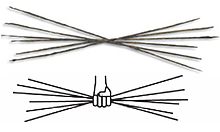- Obol (coin)
-
For the brachiopod genus, see Obolus (brachiopod).Not to be confused with Obelus.
 Above: Six rod-shaped obeloi (oboloi) displayed at the Numismatic Museum of Athens, discovered at Heraion of Argos. Below: grasp of six oboloi forming one drachma, i.e. a "handful"
Above: Six rod-shaped obeloi (oboloi) displayed at the Numismatic Museum of Athens, discovered at Heraion of Argos. Below: grasp of six oboloi forming one drachma, i.e. a "handful" Silver obol of the Greco-Bactrian king Demetrius. Extremely small (12 millimeters in diameter), but beautifully crafted.
Silver obol of the Greco-Bactrian king Demetrius. Extremely small (12 millimeters in diameter), but beautifully crafted.
The obol (ancient Greek: ὀβολός obolos, literally "spit, iron rod" plural: ὀβολοί oboloí; hence also obolus, obolos) was an ancient silver coin. In Classical Athens, there were six obols to the drachma, lioterally "handful"; it could be excahnged for eight chalkoi (χαλκοί "copper pieces"). Two obols made a diobol, weighing around 1.41-1.43 grams of silver. Triobols were also in use.
In English, the coin is usually called obol. An obelískos (ὀβελίσκος, obelisk) is a "small obol", called so in jest because of its huge size.
According to Plutarch, the Spartans had an iron obolus of four chalkoi. Sparta chose to retain the use of the cumbersome, impractical "oboloi" rather than coins proper, so as to discourage the pursuit of wealth. The obolus is also a measurement of weight. In ancient Greece it was defined as one sixth of a drachma, or about 0.5 gram. In ancient Rome it was defined as 1/48 of a Roman ounce, or about 0.57 gram, but was never issued as a coin as part of the early republican coinage system. Below the drachm was the dupondius (1/5) to the quartuncia (1/480).[1] In modern Greece it is equivalent to one decigram, or 0.1 gram.
The word "obolos", also "obelos" (ὀβελός) or "odelos" (ὀδελός) in other dialects, means a long thin metal nail or rod, such as a spit.[2] "Oboloi" were used as currency in early times. They represented small ingots of copper or bronze of standardized weight, and were traded as such. The French archaeologist T. Reinach defined them as "ustensiles monnais" i.e. utensils-money. During excavations at Argos in the Peloponnese, several dozens of rod-shaped oboloi were uncovered. They are dated well before 800 BC and they are displayed at the Numismatic Museum of Athens.
According to a nurse in Eubulus' Pamphilus, for the price of an obol, one could obtain a kantharos with a chous of wine, equivalent to about six ounces (three liters).[3] Three obols was the standard fee paid for a prostitute's services.
A coin for Charon
Main article: Charon's obolThe deceased were buried with an obolus, placed in the mouth of the corpse, in order that, once a dead person's shade reached the underworld of Hades, it would be able to pay Charon for passage across the river Acheron. Those without enough wealth, or whose friends refused to follow proper burial rites, were forced to wander the banks of the Acheron for one hundred years.
The obolus, along with the mirror, was a symbol of new schismatic heretics in the short story "The Theologians" by Argentine author Jorge Luis Borges (Labyrinths, p. 122).[4] In the story's discussion of the circularity of time, eternity, and the transmigration of the soul through several bodies the author uses a quote of Luke 12:59, translated as "no one will be released from prison until he has paid the last obolus."[5]
References
- ^ Sayles, Wayne G. (1997). Ancient coin collecting 3. Iola: Krause Publications. pp. 19. ISBN 0-87341-533-7.
- ^ LSJ entry ὀβολός (other variants: ὀβελός, ὀβελλός, ὀδελός)
- ^ Davidson, James (1998). Courtesans and Fishcakes: The Consuming Passions of Classical Athens. London: Fontana Press. pp. 59. ISBN 0-00686-343-4.
- ^ Borges, Jorge Luis (1962). Labyrinths. New York: New Directions Publishing Corporation. pp. 122–24. ISBN 0-08112-0012-4.
- ^ Borges, Jorge Luis (1962). Labyrinths. New York: New Directions Publishing Corporation. pp. 122–24. ISBN 0-08112-0012-4.
External links
- A History of Measures The Use of Obeliskoi
Categories:- Numismatics
- Coins of ancient Greece
Wikimedia Foundation. 2010.



